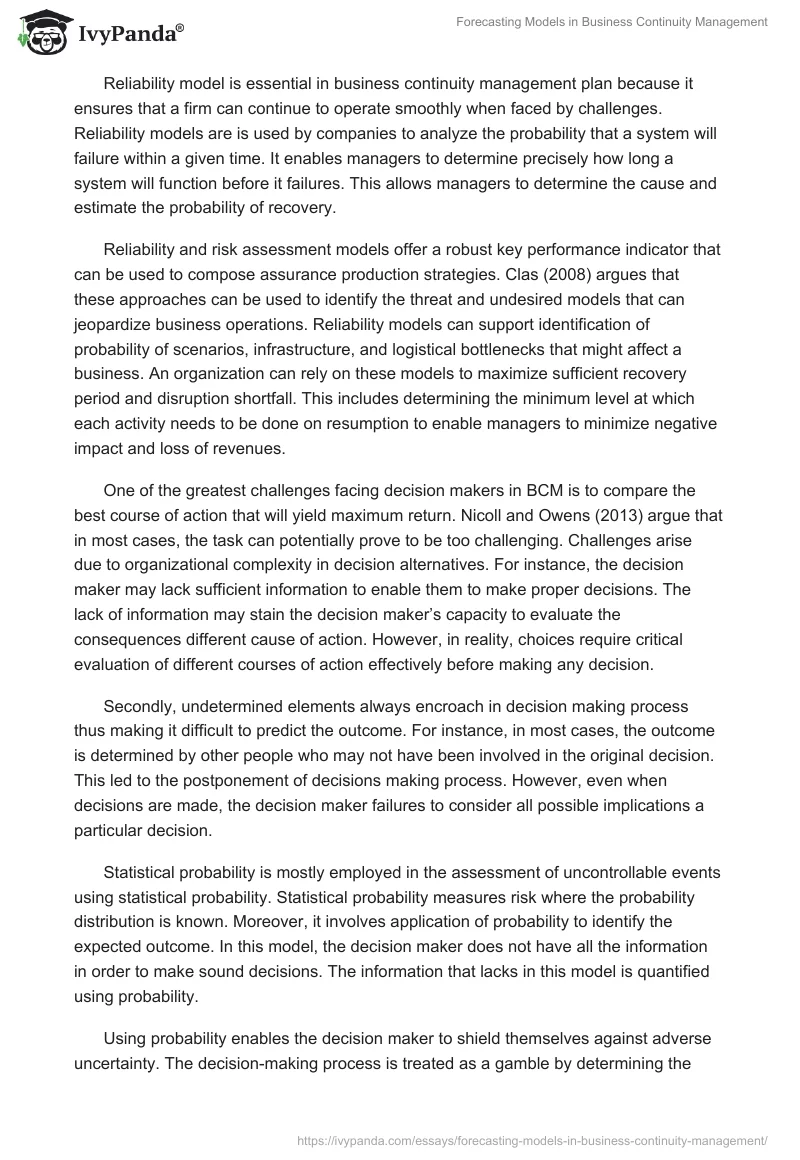Exponential smoothing is one of the common forecasting models used by many organizations today. The exponential model generates an accurate forecast that can be applied in automated systems. Consequently, the method can be used in large-scale forecasting. Engemann and Henderson (2012) noted that exponential smoothing is a time series technique which is based on historical data of a forecast. It is mostly applicable in situations where there is reasonable continuity between the past and the future. Thus, the statistical technique is best suited for short term decision making that can easily be identified based on current and future trends.
In the long term, these assumptions can potentially become difficult and unreliable because variables changes significantly due to changes in technology and improved efficiency. For instance, I have spent the last 6 out of seven days working on linear regression computations. Next week, I forecast that I will spend 6 out of seven days in front of a computer working on linear regression Excel computation.
Linear regression is used to forecast future values of a company such as demand metrics and other variables that predict economic climate. Linear regression can be employed in the casual model with several explanatory variables. This model is best suited where there is no time component. For instance, it can be used to forecast when a metal will melt under different conditions by developing a line of best fit based on historical performance to predict the future outcome.
Regression model can be used to forecast business continuity and risk management program. Linear regression is a forecasting model that uses the assumption of the underlying factor when it is possible to identify some variable that influences a given variable (Tammineedi, 2010). For instance, regression can be used in business continuity management (BCM) to forecast future sales based on weather conditions which can enable supermarkets to predict umbrella sales in a given period. It is also a seasonality model that can allow hotels to predict how sales will increase or decrease during summer and winter.
Reliability model is essential in business continuity management plan because it ensures that a firm can continue to operate smoothly when faced by challenges. Reliability models are is used by companies to analyze the probability that a system will failure within a given time. It enables managers to determine precisely how long a system will function before it failures. This allows managers to determine the cause and estimate the probability of recovery.
Reliability and risk assessment models offer a robust key performance indicator that can be used to compose assurance production strategies. Clas (2008) argues that these approaches can be used to identify the threat and undesired models that can jeopardize business operations. Reliability models can support identification of probability of scenarios, infrastructure, and logistical bottlenecks that might affect a business. An organization can rely on these models to maximize sufficient recovery period and disruption shortfall. This includes determining the minimum level at which each activity needs to be done on resumption to enable managers to minimize negative impact and loss of revenues.
One of the greatest challenges facing decision makers in BCM is to compare the best course of action that will yield maximum return. Nicoll and Owens (2013) argue that in most cases, the task can potentially prove to be too challenging. Challenges arise due to organizational complexity in decision alternatives. For instance, the decision maker may lack sufficient information to enable them to make proper decisions. The lack of information may stain the decision maker’s capacity to evaluate the consequences different cause of action. However, in reality, choices require critical evaluation of different courses of action effectively before making any decision.
Secondly, undetermined elements always encroach in decision making process thus making it difficult to predict the outcome. For instance, in most cases, the outcome is determined by other people who may not have been involved in the original decision. This led to the postponement of decisions making process. However, even when decisions are made, the decision maker failures to consider all possible implications a particular decision.
Statistical probability is mostly employed in the assessment of uncontrollable events using statistical probability. Statistical probability measures risk where the probability distribution is known. Moreover, it involves application of probability to identify the expected outcome. In this model, the decision maker does not have all the information in order to make sound decisions. The information that lacks in this model is quantified using probability.
Using probability enables the decision maker to shield themselves against adverse uncertainty. The decision-making process is treated as a gamble by determining the tradeoff value of an individual outcome against its probability (Jedynak, 2013). For instance, if we want to establish the possibility of a child choosing vanilla ice cream from other flavors, this data can be obtained from surveys. Presumably, if out of 100 children only 35% chose vanilla; the probability that a child at any given time will choose vanilla is 0.35.
References
Clas, E. (2008). Business Continuity Plans. (Cover story). Professional Safety, 53(9), 45-48. Web.
Engemann, K. & Henderson, D. (2012). Business continuity and risk management: essentials of organizational resilience. Brookfield, Connecticut, USA: Rothstein Associates Inc., Publisher. Web.
Jedynak, P. (2013). Business continuity management – perspective of management science. Contemporary Management Quarterly / Wspólczesne Zarzadzanie, 12(4), 85-96. Web.
Nicoll, S. R., & Owens, R. W. (2013). Emergency Response & Business Continuity. Professional Safety, 58(9), 50-55. Web.
Tammineedi, R. L. (2010). Business Continuity Management: A Standards-Based Approach. Information Security Journal: A Global Perspective, 19(1), 36-50. Web.


